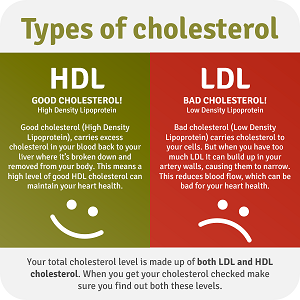Maintaining Your Cholesterol For A Healthy Heart

Most people have heard about it, read about it, know someone who is at risk or even has it – high cholesterol, which can lead to stroke, heart attack or heart disease. Some of the latest statistics show that heart disease is the leading cause of death in the United States claiming nearly 500,000 lives a year.
Cholesterol is made in the liver and found in certain foods such as dairy products, eggs and meat. The body requires only a small amount of cholesterol in order to function properly and produce hormones, vitamin D and bile acids that help to digest fat. When too much cholesterol is present in the body, atherosclerosis develops and leads to health issues such as heart disease (coronary artery disease) and stroke.
High cholesterol is one of the many risk factors for heart disease, and learning how to manage it is essential to heart health. High cholesterol is usually associated with too much low density lipoprotein (LDL) or “bad” cholesterol in the body. The LDL can form a plaque that may build up on the inside walls of the arteries, blocking the flow of blood. If an artery that supplies blood to the heart or brain is completely blocked, the result can be a stroke or heart attack. The optimal LDL level depends on your risk factors and history. Cholesterol is not the only risk factor for heart disease; others include smoking, family history of heart disease, age and obesity.
High density lipoprotein (HDL), is a type of cholesterol that is actually good for heart health. This type of cholesterol helps the body get rid of bad cholesterol in the blood; therefore, the higher level of HDL cholesterol, the better. The optimal HDL range for women is 50 – 60mg and for men is 40 – 50mg. There are several ways to increase the levels of HDL in the body:
- Increase aerobic exercise
- Stop smoking
- Lose weight
- Reduce the intake of trans fatty acids
- Add soluble fiber in your diet
Depending on the clinical circumstances, dietary changes and exercise are typically the first course of action in trying to increase HDL and reduce LDL cholesterol. If after following a diet low in cholesterol, low saturated fat and increased exercise, but still can’t reach your cholesterol goal, your physician may prescribe a cholesterol medication to lower the cholesterol and LDL and or increase the HDL as part of your heart healthy regimen.
About the Author: Paul Suri, M.D. of Haven Cardiology is board certified in cardiovascular disease and clinical cardiac electrophysiology, the study of heart rhythms by the American Board of Internal Medicine. Dr. Suri earned his Doctor of Medicine degree from the University of Texas and served his residency at Georgetown University Medical Center.
Dr. Suri focuses on preventive cardiology including:
- Nutrition/Lifestyle management- through diet, exercise and medication as needed to prevent symptomatic cardiovascular disease and slow the progression and potentially reverse the severity in cases where it has progressed clinically.
- Detection and management of Atrial Fibrillation and other abnormal heart rhythm issues such as syncope (loss of consciousness) and palpitations.
- Post cardiac and vascular surgery care
- Post heart attack and coronary artery or peripheral vascular stenting care
- Patients with Diabetes, High blood pressure, Kidney disease and other risk factors for cardiovascular disease.
- Patients with symptoms of claudication (pain in legs with walking), Dyspnea (shortness of breath), Stroke/TIA, Edema (swelling from accumulation of fluid).
- Implanting and monitoring of pacemakers, defibrillators and heart failure pacemakers.
Story Credit: http://www.lockhaven.com/news/health/2017/08/maintaining-your-cholesterol-for-a-healthy-heart/


